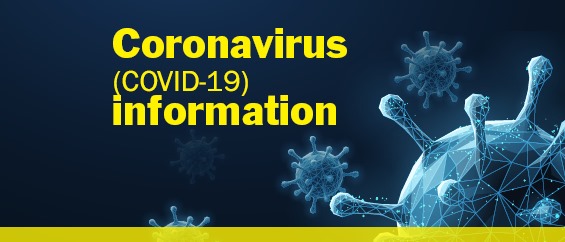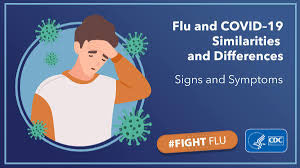
OCEAN COUNTY TO INCREASE HOURS AT OCEAN COUNTY COLLEGE COVID-19 DRIVE THRU TESTING SITE
November 19, 2020
OCEAN COUNTY TO INCREASE HOURS AND INCLUDE SATURDAYS AT OCEAN COUNTY COLLEGE COVID-19 DRIVE THRU TESTING SITE
November 30, 2020
It’s not easy to tell the difference but seeking medical guidance ASAP is recommended
(Toms River) – The Ocean County Health Department (OCHD) and the rest of the public health community anticipated there would be a number of challenges as the COVID-19 pandemic converged with the current flu season. After all, some of the symptoms of flu and COVID-19 are similar, making it difficult to tell the difference between them based on symptoms alone.
Influenza (Flu) and COVID-19 are both contagious respiratory illnesses, but they are caused by different viruses. COVID-19 is caused by infection with a new coronavirus (called SARS-CoV-2) and flu is caused by infection with influenza viruses.
“The flu and COVID-19 certainly share many characteristics, but there are some important differences between the two,” said Daniel Regenye, OCHD Public Health Coordinator/Health Officer. “But to determine the difference isn’t simple based on just an individual’s symptoms and so this is where testing may be needed to help confirm a diagnosis.”
What concerns public health officials – especially as cases rise throughout the State and across the country – is that some people are dismissing COVID-19 symptoms believing it may be just the flu. The problem is they continue to have contact with others and potentially spread the virus before seeking medical guidance or not at all.
“We’re seeing down the road through contact tracing that individuals that start with flu-like symptoms try to be optimistic and believe it’s only a quick flu bug or cold,” explained Patty High, OCHD Assistant Public Health Officer. “Additionally, they don’t want to sacrifice social plans or potentially be restricted by a quarantine or isolation period. We need these individuals to err on the side of caution by contacting a health care provider for guidance once they start demonstrating any of the symptoms.”
Both COVID-19 and flu can have varying degrees of signs and symptoms, ranging from no symptoms (asymptomatic) to severe symptoms. Another important difference is there is a vaccine to protect against flu. There is still no Federal Drug Administration (FDA) approved COVID-19 vaccine despite reports of several pending. The best way to still prevent COVID-19 infection is avoid being exposed to the virus by following safety precautions.
The most prominent symptoms that COVID-19 and the flu have in common include:
- Fever (of more than 100 degrees Fahrenheit)
- Chills
- Headache
- Cough
- Muscle pain and body aches
- Fatigue (extreme tiredness or lack of energy) and weakness
- Nausea or vomiting (more common in children than adults)
- Diarrhea (more common in children and adults)
Remember, we’re still learning more about COVID-19 every day. While there are many similarities with flu symptoms, these are some specific differences that have been identified so far, including:
- Symptom onset – The flu comes on suddenly. Usually flu symptoms appear anywhere from one to four days after infection. COVID-19 symptoms can be more gradual. While COVID-19 symptoms can develop as early as two days after you’re infected, the Centers for Disease Control and Prevention (CDC) says five days after infection is typical. Plus, it’s possible to be infected with COVID-19 but not show any symptoms for up to 14 days.
- Cough type and severity – The flu usually causes a mild, dry cough, whereas COVID-19 cough symptoms are more severe. When you have COVID-19, coughs are usually dry, persistent and can leave you short of breath.
- Unique symptoms – COVID-19 symptoms that don’t typically overlap or are less common with the flu include:
- Shortness of breath or difficulty breathing
- Runny or stuffy nose
- Sore throat
- Repeated shaking with chills
- New and sudden loss of taste or smell
The OCHD urges residents that if they believe they – or their children – have any of these symptoms they should take the proper precautions. Speak with a health care professional to discuss options such as being tested, self-monitoring or other recommendations.
“COVID-19 cases are rising quickly all over New Jersey and across the US for a variety of reasons this Fall,” Regenye added. “Don’t take either virus lightly but when it comes to COVID-19 we need everyone’s cooperation if we expect to reverse this current uptick and reduce potential spread particularly during this holiday season.”
For additional information on COVID-19 and flu similarities please visit www.cdc.gov, and www.ochd.org. You can also follow the Ocean County Health Department on our Facebook page or Twitter @OCpublichealth.
The OCHD is also providing a general COVID-19 Information Call Hot Line for residents and clinicians to answer questions regarding the coronavirus. The number is 732-341-9700 ext. 7411.
The NJDOH (NJPIES) hotline is available for questions around the clock at 1-800-222-1222 or by dialing 2-1-1. Other related sources; for medical COVID-19 questions call 1-800-962-1253 or Text NJCOVID to 898-211 to receive alerts.




